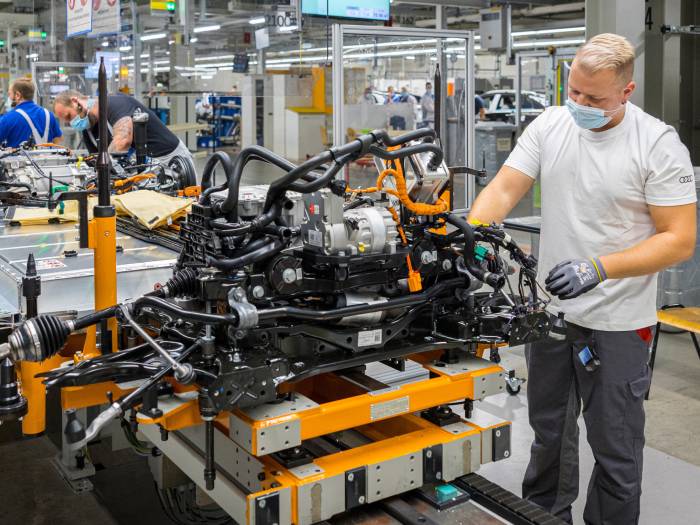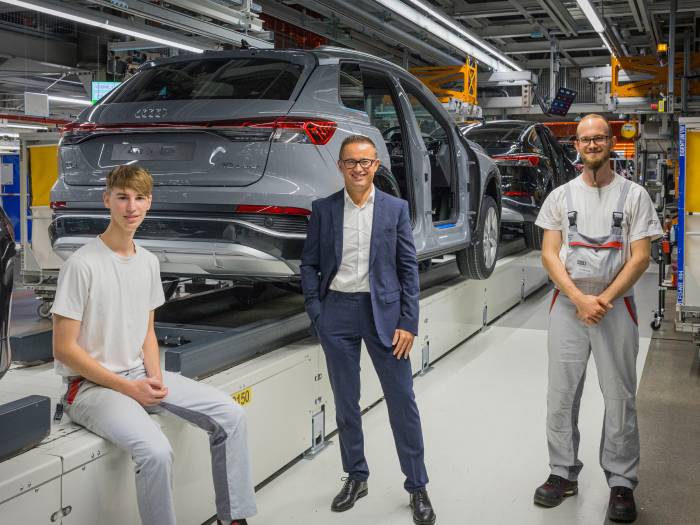The importance of synergies in the transition to e-mobility
Synergies within the Volkswagen Group are essential for the transition to a zero-emission mobility. The MEB platform and the Zwickau plant are two excellent examples of this.
Starting in 2026 Audi will launch on the global market only new 100% electric models and by 2033 the company will gradually phase out the production of internal combustion engines, focusing on electric mobility and accelerating its transformation. The goal is to make individual mobility sustainable while at the same time managing to increase profitability as a company.
Following this direction, the Audi Q4 e-tron e Q4 Sportback e-tron play a central role in the electrification strategy, since they offer customers an attractive point of entry into electric premium mobility, thanks to the Volkswagen Group's MEB platform: Audi's 100% electric compact SUVs are produced in the multi-brand Zwickau plant, together with the Volkswagen ID.3 and ID.4 and the Cupra Born.
Platforms and synergies

“In the future, we will rely event more intensively on synergies within the Volkswagen Group. This close collaboration makes the transition to emissions-free premium mobility affordable for our customers and economically presentable for us. At the same time, we make sure that all our vehicles unmistakably carry the Audi DNA within them and leave the assembly line in almost proverbially premium quality" explains Peter Kössler, Member of the Board of Directors of Audi AG for Production and Logistics.
The next important 100% electric model, the Audi Q6 e-tron, will also be based on a new group platform: the Premium Platform Electric (PPE), developed jointly with Porsche.
A flexible plant
At the Zwickau plant, around 8,500 employees are producing the Volkswagen Group’s five current electric models. "Transforming a Volkswagen factory into a multi-brand plant that will soon produce six electric cars has been a special challenge, especially for our employees who are responding with tremendous engagement and skill," says Stefan Loth, Chairman of the Zwickau plant.
In the assembly process, many innovative technologies are being used, which allow in particular to install some components directly on the line: this is the case of the head-up display, thanks to an intelligent software able to perform the calibration autonomously.
Audi Q4 e-tron

Using shared platforms and technical modules has been a proven strategy in the Volkswagen Group for decades. "Teamwork between the different brands starts when a new platform is conceived. It’s important to establish the right balance between maximum synergy and the distinctive character of each brand" explains Fermín Soneira Santos, Head of the product line for the electric models from segment A to segment C of AUDI AG.
The Q4 e-tron, for example, is unmistakably an Audi, not only thanks to its progressive design, but also thanks to the very high quality of the materials and interiors and to the philosophy of the human-machine interface that combines the virtual cockpit, the head -up augmented reality display and the MMI infotainment system creating an innovative interaction between virtual and real worlds.
Sharing skills

The benefits of cross-brand collaboration are evident also among the employees: for example at the moment, approximately 350 Audi technicians are engaged in production in Zwickau, primarily junior profiles who have just completed their vocational training. After their one-year assignment in Zwickau, they will bring their experience on e-mobility back to their original locations, for instance in Ingolstadt for the production of the Q6 e-tron, which will be on the market starting in 2023.
Source: AUDI AG
VGI | Responsible OU: VP | Creation date: article date | Class 9.1
